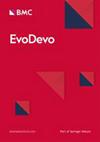棘皮动物中粘连蛋白超家族成员的全基因组鉴定和时空表达分析
IF 4.1
2区 生物学
Q1 DEVELOPMENTAL BIOLOGY
引用次数: 0
摘要
粘附蛋白是一种钙依赖性跨膜细胞-细胞粘附蛋白,对拟步态动物的发育至关重要。它们由三个亚家族组成:结合 catenin 的经典粘附蛋白、含有 6-7 个钙结合重复结构域的原粘附蛋白和非典型粘附蛋白。它们的功能包括形成粘连接头、建立平面细胞极性(PCP)以及调节细胞形状、增殖和迁移。由于棘皮动物是基底半脊椎动物,它们为研究两栖动物的进化提供了重要依据,但它们唯一表征清楚的粘附蛋白是G-粘附蛋白,这是一种经典的粘附蛋白,许多胚胎上皮都表达这种蛋白。我们的目的是通过系统进化分析和研究棘皮动物发育过程中粘附蛋白编码基因的时空表达模式,更好地描述棘皮动物粘附蛋白的特征。我们对两个棘皮动物、三个类星体和一个板齿动物物种进行了系统发育分析,发现了十个棘皮动物的粘附蛋白,包括一个氘体特异的直向同源物--粘附蛋白-23,以及一个棘皮动物特异的非典型粘附蛋白,该粘附蛋白可能产生于棘皮动物-类星体的祖先。研究发现,dachsous-2直向同源物中的Catenin结合结构域是一种氘体特异性创新,在小鼠中选择性丢失,而Fat4直向同源物中的结合结构域似乎是Ambulacraria特异性的,在非棘皮动物中选择性丢失。已鉴定的棘皮动物粘附蛋白缺乏脊椎动物特异性的创新,但包含了两个存在于原生动物而不存在于小鼠的蛋白。四种胚胎表达的黏附蛋白(脂肪非典型黏附蛋白1和4、dachsous-2和原黏附蛋白-9)的时空表达模式是动态的,并反映了Frizzled 5/8的表达模式,Frizzled 5/8是一种非经典的Wnt PCP通路受体蛋白,对弓形虫的形态发生至关重要。棘皮动物的粘附蛋白工具包更类似于早于原生动物和去古脊椎动物的古代双脊类动物的粘附蛋白工具包,而不是现生脊椎动物的粘附蛋白工具包。不过,去古脊椎动物似乎也经历了几次与粘附蛋白有关的革新。基于它们相似的时空表达模式以及与五氯苯酚相关蛋白和肿瘤抑制蛋白的同源关系,我们推测海胆粘附蛋白可能在调节胚胎上皮和器官的形状与生长方面发挥作用。未来的实验将研究非棘皮动物中的粘附蛋白表达,并探索粘附蛋白在棘皮动物发育过程中的功能。本文章由计算机程序翻译,如有差异,请以英文原文为准。
Genome-wide identification and spatiotemporal expression analysis of cadherin superfamily members in echinoderms
Cadherins are calcium-dependent transmembrane cell–cell adhesion proteins that are essential for metazoan development. They consist of three subfamilies: classical cadherins, which bind catenin, protocadherins, which contain 6–7 calcium-binding repeat domains, and atypical cadherins. Their functions include forming adherens junctions, establishing planar cell polarity (PCP), and regulating cell shape, proliferation, and migration. Because they are basal deuterostomes, echinoderms provide important insights into bilaterian evolution, but their only well-characterized cadherin is G-cadherin, a classical cadherin that is expressed by many embryonic epithelia. We aimed to better characterize echinoderm cadherins by conducting phylogenetic analyses and examining the spatiotemporal expression patterns of cadherin-encoding genes during Strongylocentrotus purpuratus development. Our phylogenetic analyses conducted on two echinoid, three asteroid, and one crinoid species identified ten echinoderm cadherins, including one deuterostome-specific ortholog, cadherin-23, and an echinoderm-specific atypical cadherin that possibly arose in an echinoid-asteroid ancestor. Catenin-binding domains in dachsous-2 orthologs were found to be a deuterostome-specific innovation that was selectively lost in mouse, while those in Fat4 orthologs appeared to be Ambulacraria-specific and were selectively lost in non-crinoid echinoderms. The identified suite of echinoderm cadherins lacks vertebrate-specific innovations but contains two proteins that are present in protostomes and absent from mouse. The spatiotemporal expression patterns of four embryonically expressed cadherins (fat atypical cadherins 1 and 4, dachsous-2, and protocadherin-9) were dynamic and mirrored the expression pattern of Frizzled 5/8, a non-canonical Wnt PCP pathway receptor protein essential for archenteron morphogenesis. The echinoderm cadherin toolkit is more similar to that of an ancient bilaterian predating protostomes and deuterostomes than it is to the suite of cadherins found in extant vertebrates. However, it also appears that deuterostomes underwent several cadherin-related innovations. Based on their similar spatiotemporal expression patterns and orthologous relationships to PCP-related and tumor-suppressing proteins, we hypothesize that sea urchin cadherins may play a role in regulating the shape and growth of embryonic epithelia and organs. Future experiments will examine cadherin expression in non-echinoid echinoderms and explore the functions of cadherins during echinoderm development.
求助全文
通过发布文献求助,成功后即可免费获取论文全文。
去求助
来源期刊

Evodevo
EVOLUTIONARY BIOLOGY-DEVELOPMENTAL BIOLOGY
CiteScore
7.50
自引率
0.00%
发文量
18
审稿时长
>12 weeks
期刊介绍:
EvoDevo publishes articles on a broad range of topics associated with the translation of genotype to phenotype in a phylogenetic context. Understanding the history of life, the evolution of novelty and the generation of form, whether through embryogenesis, budding, or regeneration are amongst the greatest challenges in biology. We support the understanding of these processes through the many complementary approaches that characterize the field of evo-devo.
The focus of the journal is on research that promotes understanding of the pattern and process of morphological evolution.
All articles that fulfill this aim will be welcome, in particular: evolution of pattern; formation comparative gene function/expression; life history evolution; homology and character evolution; comparative genomics; phylogenetics and palaeontology
 求助内容:
求助内容: 应助结果提醒方式:
应助结果提醒方式:


